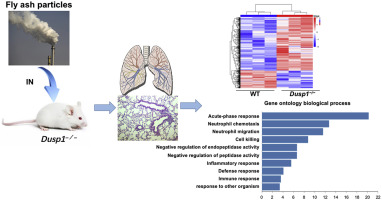当前位置:
X-MOL 学术
›
Ecotox. Environ. Saf.
›
论文详情
Our official English website, www.x-mol.net, welcomes your
feedback! (Note: you will need to create a separate account there.)
Comparative transcriptome analysis reveals Dusp1 as a critical regulator of inflammatory response to fly ash particle exposure in mouse.
Ecotoxicology and Environmental Safety ( IF 6.2 ) Pub Date : 2020-01-03 , DOI: 10.1016/j.ecoenv.2019.110116 Jingwen Zhang 1 , Yiping Chen 1 , Akhileshwar Namani 2 , Mohamed Elshaer 2 , Zhinong Jiang 3 , Hongfei Shi 4 , Xiuwen Tang 2 , Xiu Jun Wang 1
Ecotoxicology and Environmental Safety ( IF 6.2 ) Pub Date : 2020-01-03 , DOI: 10.1016/j.ecoenv.2019.110116 Jingwen Zhang 1 , Yiping Chen 1 , Akhileshwar Namani 2 , Mohamed Elshaer 2 , Zhinong Jiang 3 , Hongfei Shi 4 , Xiuwen Tang 2 , Xiu Jun Wang 1
Affiliation

|
Exposure to outdoor concentrations of fine particulate matter (PM2.5) is a leading global health concern. Waste incineration emission has been recognized as a potential major contributor of ambient PM2.5. Respiratory inflammation is a central feature induced by PM2.5 exposure by inhalation. However, the molecular mechanisms are not fully understood. Dual-specificity phosphatase 1 (Dusp1) plays an instrumental role in the regulation of airway inflammation. In this study, fly ash particles (20 mg/kg BW) collected from a municipal waste incinerator in China were given to BALB/c wild-type (WT) and Dusp1-/- mice by intranasal administration daily for three consecutive days. While these particles induced mild inflammation in both genotypes, a significantly higher level of serum interleukin-6 (665 pg/ml) was measured in Dusp1-/- mice challenged with fly ash particles than in their WT counterparts. Genome-wide transcriptome profiling of pulmonary coding genes in response to the exposure were performed in both genotypes by RNA sequencing. We identified 487 differentially-expressed genes (DEGs) in fly ash-challenged Dusp1-/- mice versus their WT counterparts with a log2fold-change >1.5 and p < 0.05. Functional enrichment and molecular pathway mapping of the DEGs specific to Dusp1-/- mice exposed to the particles revealed that the top 10 perturbed molecular pathways were associated with the immune response. Our study demonstrates the anti-inflammatory role of Dusp1 in protecting the lung against insults by fly ash particles, suggesting that Dusp1 might be a therapeutic target for the treatment of PM2.5-induced respiratory diseases.
更新日期:2020-01-06











































 京公网安备 11010802027423号
京公网安备 11010802027423号